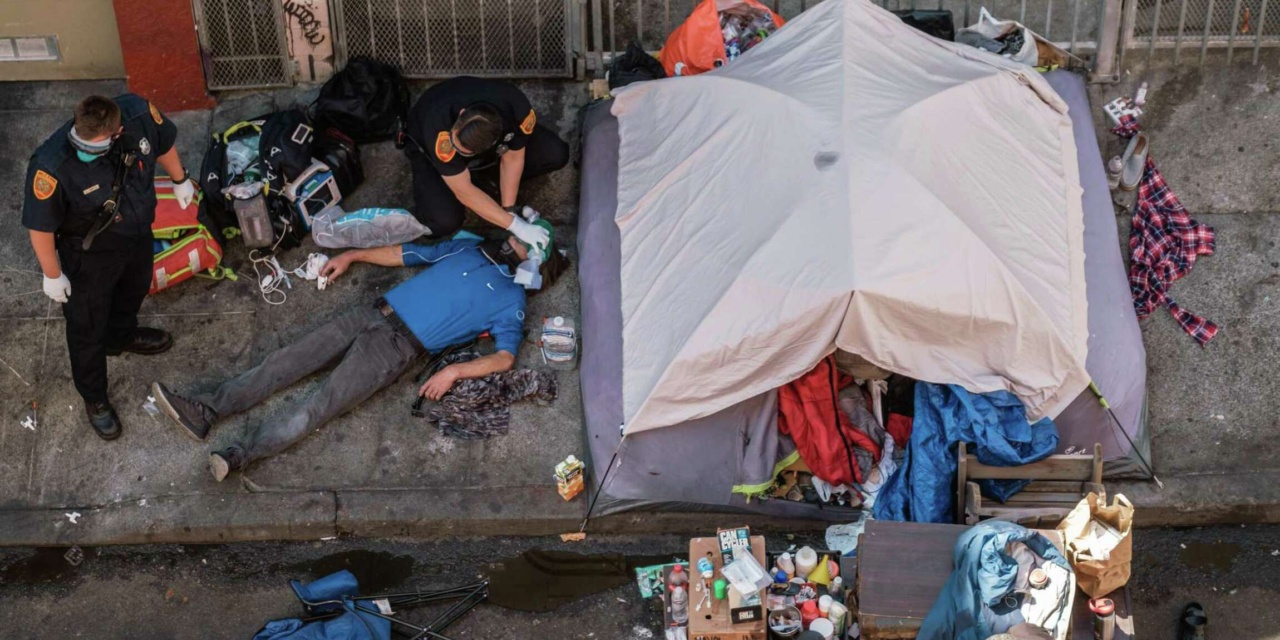Paramedics work to revive an overdose victim in the Tenderloin in San Francisco, California, July 11, 2020 (Nick Otto/San Francisco Chronicle)
In San Francisco’s Union Square, designer shops cover every inch of the real estate: Louis Vuitton, Dolce & Gabbana, Gucci. On the adjacent streets are 4- and 5-star hotels.
But just off the square, outside some of these hotels and high-end department stores such as Macy’s, you can see the sleeping bags and cardboard that are the shelter for some of the city’s homeless. After nightfall — even during the day — drugs are being smoked, injected or snorted.
Men with briefcases and suits enter the towers of banks and insurance companies in the Financial District. At the foot of the skyscrapers, disoriented people scream to themselves or shout at inanimate objects.
Turn right into one neighborhood and you will see Victorian-style homes valued at millions of dollars, perfectly painted with the embellishment of gold trimming. Turn left and some in the street are partially clothed, sometimes with remnants of their own excrement. Needles are tossed carelessly onto a concrete dumping ground, even beside children’s play areas.
The Tenderloin was once renowned for its quirky art scene, indie shows, and musical venues. Now the windows of storefronts are boarded up, items in shops are locked down, and trash covers the sidewalks. Drivers leave messages on car windows that no valuables have been left inside.
Drug dealers are active in the streets. Their names are common knowledge. Little is done to apprehend them.
Thomas Wolf, a former addict, says the area is the largest open-air drug market in the US: “Nowhere else is it easier to be addicted to drugs than in San Francisco, and specifically in the Tenderloin.”
The Fentanyl Crisis
In the first quarter of 2023, 200 people died in San Francisco from drug-related overdoses — about one victim every 10 hours — in comparison to 142 in the same period in 2022. The homeless are particularly vulnerable, making up 2/3rds of the fatalities.
While various drugs are responsible for the deaths, the biggest killer appears to be the opiate fentanyl, a painkiller which is 100 times stronger than morphine and50 times more potent than heroin. Its low cost has propelled it onto the streets as a common recreational drug, to be smoked, snorted, or injected. In a recent poll, 27% of 846 respondents said that a family member was addicted.
Since the beginning of May, California Law Enforcement have seized in San Francisco enough fentanyl to cause more than 2 million overdose deaths. Fentanyl’s lethality stems from its potency — even a low dose can be fatal — and its sedative effect. An individual who may be endangered is unable to stand up, let alone move properly.
One addict says, “It has turned your average users into desperate, violent people who will do anything to get the next fix.”
The problem is compounded by the influx of users into the city. At the beginning of the summer, San Franciscan police made about 45 arrests of individuals shooting up in the street. Only three were residents.
Former addict Thomas Wolf explains:
Everyone knows that San Francisco kind of takes a hands-off approach to law enforcement. So people know that if they come to San Francisco they can get high, they can probably score a free tent, get money from the government, and get food stamps and health insurance for free while living on the street.
Care or Punishment?
Chesa Boudin, San Francisco’s District Attorney, has argued that with respect to the proliferation of drugs, you “cannot prosecute your way out of it”.
That position emanates in part from California Law. Proposition 36, enacted in 2000, allows defendants convicted of non-violent drug possession offenses to receive a probationary sentence in lieu of incarceration. Proposition 47 of November 2014 reduces most offenses from felonies to misdemeanors.
The focus on rehabilitation, with sourcing of housing, provision of treatment, and address of health issues has come up against the stance of San Francisco Mayor London Breed. A Democrat like Boudin, she contends that this approach could indicate acceptance or even weakness in the face of the drug problem.
The legal and political clash has played out in the debate over “safe spaces” such as 1172 Market Street, with a capacity of 100 people, or the sobriety unit in SoMa Rise on Howard Street. The benefits of offering recovery off the streets is set again images of resident passed out amid used needles on the ground behind a rickety barbed fence.
Governor Gavin Newsom has doubled down on enforcement with seizures of fentanyl, a doubling of police officers on the streets, and a vow to take down drug gangs. Meanwhile, he has vetoed legislation for the erection of three supervised drug shelters in the state.
In this tug-of-war, compounded by the high cost of housing in San Francisco, the toll continues. Mothers Against Drug Death has been established and organized a rallies in the city, but there is a sense of helplessness.
Michelle Leopard, who lost her 18-year-old son in 2019 to an overdose, says sadly, “I know that there’s a lot of stigma around addiction that needs to be changed.”


Nothing will be done about this. The US is too busy resurrecting the Cold War. All the money that could have been spent on treatment programs, affordable housing, and other resources, to help Americans suffering from substance abuse, social diseases, and mental illness, ended up in Zelenskey’s pockets. It’s strange that this article was published here. EA Worldview has been cheerleading the proxy war for the past nineteen months. Why would it call attention to this?